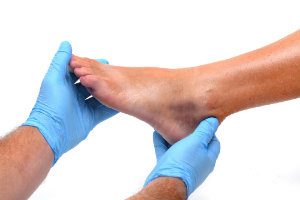Ankle Fracture
HELP Now and through recoveryYou can easily understand why a child might break an ankle. They are always running around or jumping off things and twisting the joint or landing hard on their heels. What you may not know is that the injury is increasing among older adults.
As baby boomers try to stay more active, ankle fractures are on the rise in that population, too. Knowing why they happen and how to deal with them will give you an edge if it happens to you or someone you care for.
Defining the Injury

The joint is composed of the enlarged ends of the tibia and fibula (leg bones) and the talus—a bone that nestles above your heel bone. These are held together by strong ligaments that expand and contract to allow the bones to move.
When there is a strong impact (as in landing from a jump) or severe twisting or rolling of the joint (as in a trip, fall, or sports action), the ligaments can stretch too far and you could have a sprained ankle. When the force is so severe that one or more bone breaks occur, you have an ankle fracture.
Diagnosing a Broken Ankle
You may feel pain immediately, and the area will be tender when you touch it. Swelling and bruising often follow, and it may hurt too much to bear any weight on it. If the bones have moved out of position, the entire joint may look deformed. A bad sprain could also have some of these symptoms, but it is best to have us check it out rather than assume it’s “only a sprain.”
We may be able to diagnose a break just with a physical examination of the ankle, but to know exactly what we are dealing with, X-rays are usually taken to determine how bad it is and whether surgery would be a good idea.
Recovery from Ankle Fractures
If one or more of the bones is broken, you have the option of letting it heal without surgery. This usually involves immobilizing the joint in a leg cast or brace and keeping weight off it, but some minor breaks allow you to use your leg in moderation. We will need to monitor the progress with repeat X-rays, to make sure the bones stay aligned as they heal.
If the break is serious or the bones have moved out of position, surgery may be needed to realign them and keep them in place with screws or pins. Bones take at least 6 weeks to heal, and ligaments and tendons even longer. You may be able to return to daily activities in 3 to 4 months, but it is not uncommon for a bad break to not be fully back to normal for a couple of years. Take all the time you need to heal, because an incomplete recovery could lead to problems like arthritis in the joint later.
The Role of Rehab
Once your bones have sufficiently healed and ready to move again, we will likely start you with physical therapy treatments to regain full range of motion and recondition your tendons and ligaments. This is important, because if these tissues do not become strong again, your ankle may always be unstable and increase your risk for re-injury.
Excellent Care for Ankle Injuries in Ladera Ranch, CA
At Southern California Foot & Ankle Specialists, we believe the health of your feet and ankles are basic to your overall well-being and your enjoyment of life—whether you are a 6-year-old running around on the playground or a 60-year-old who still likes hiking in the mountains.
If you injure your ankle, we can determine what the problem is and design the best treatment plan so your feet can regain full health. Don’t risk greater harm by waiting to see if it gets better on its own. Call our office in Ladera Ranch, CA at (949) 364-9255 (WALK) and get well the right way.
Contact Us
Ladera Ranch
333 Corporate Dr. Ste 230, Ladera Ranch, CA 92694
Tel: (949) 364-9255 (WALK)
Fax: (949) 364-9250
Office Hours:
Monday - Friday: 9am - 5pm
*(Lunch 12 noon - 1pm)
Orange
2617 E Chapman Ave. Ste 303, Orange, CA 92869
Tel: (714) 639-7993
Fax: (714) 639-0729
Office Hours:
Monday - Friday: 9am - 5pm
*(Lunch 12 noon - 1pm)
